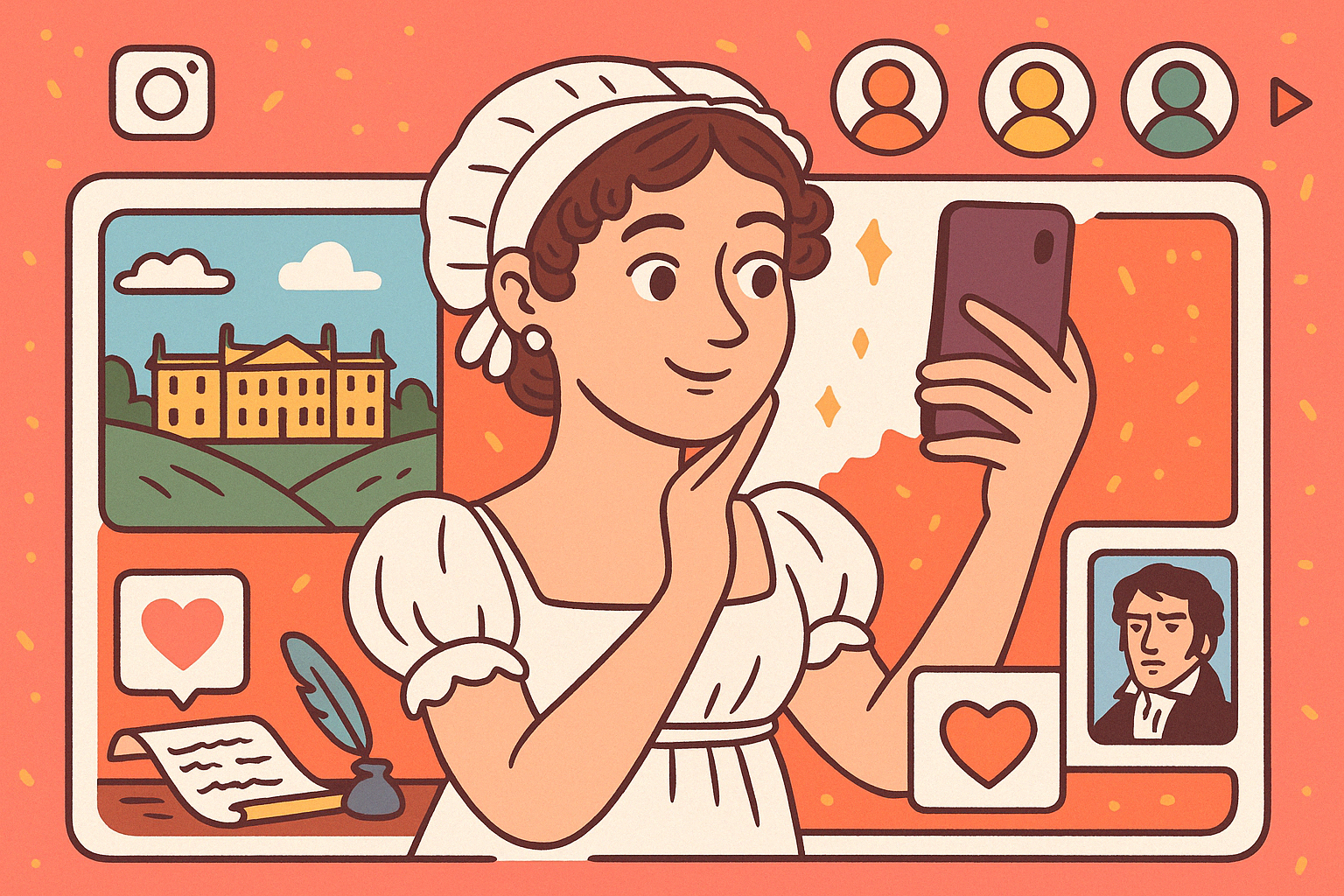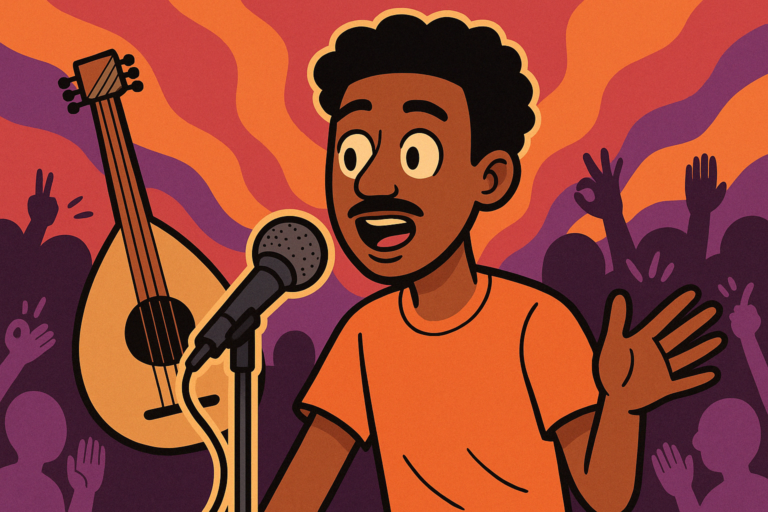What If Jane Austen Had Instagram

Okay, here’s something for you to imagine – Jane Austen, but with WiFi and a ring light. I know—it sounds ridiculous at first. But the more I looked into it, the more I realized Instagram actually has a lot in common with Austen’s world.
Both are obsessed with appearances, performance, and social currency.
And as someone who spent weeks deep-diving into both Austen’s letters and creator culture (yes, I was that person comparing Darcy to lifestyle influencers), I started seeing wild parallels.
Austen built entire narratives out of subtle glances and loaded conversations—which honestly feels like IG captions and DMs before we had those words.
Her irony?
Totally made for Stories.
Her characters?
Basically memes waiting to happen. This isn’t just fun speculation; it opens up real questions about authorship, identity, and narrative in the age of platforms.
So let’s explore: if Austen had Instagram, what would she do—and more importantly, who would she become?
Austen’s Digital Persona
So, first off—Jane Austen knew how to play a long game. She was the master of indirect characterization, and her narrative voice was always a little slippery—playful, ironic, but never fully revealing.
That kind of self-presentation?
It’s eerily close to how people curate their online personas today.
If she had an Instagram profile, I don’t think she’d be posting selfies with “good vibes only” captions. Her tone would probably be closer to that ultra-dry, knowing corner of IG where people post painfully aesthetic images with savage captions. Think: a photo of tea by the window with the caption, “It is a truth universally acknowledged that a single woman in possession of a book must be in want of no interruptions.”
Voice would be her tool, just like it was in her novels. She’d wield captions like she did free indirect discourse—subtly nudging us to see a character (or maybe herself) a certain way without saying it outright. That level of narrative control is what influencers today try to mimic: telling a story that feels authentic while actually being super curated.
Now let’s talk about the big tension: Austen’s anonymity vs. Instagram’s demand for visibility. Austen originally published anonymously—just “By a Lady”—which feels completely at odds with Instagram’s algorithm, where face and name = engagement.
But that’s what makes this thought experiment interesting. Would Austen have resisted platform norms? Or would she have adapted them to her own style of quiet, pointed rebellion?
Maybe she’d use a pseudonym and never post her face. Maybe her feed would be all soft-focus shots of countryside walks and Regency-era flatlays. (Yes, I believe she’d have a niche aesthetic.) Her “about” section might say something like “Observing society so you don’t have to.”
She also loved letters—arguably the closest 19th-century equivalent to today’s DMs. So I imagine she’d thrive in close, clever one-on-one exchanges rather than big public posts.
Her persona wouldn’t scream for attention—it would reward those who really look. That’s how she wrote her books, after all: the more you reread, the more you see what she was actually doing.
And what about snark?
Oh, she’d absolutely have passive-aggressive captions directed at people like Mr. Collins. Not in a bullying way—but in that deeply Austen-ish manner where it’s all civility on the surface, with a dagger underneath.
In short: Austen’s Instagram would be a masterclass in elegant shade, ironic performance, and controlled self-revelation. It wouldn’t look like the typical influencer feed—but it would still influence, in a quieter, smarter way.
Let’s keep going, because the real fun starts when we get into what kind of content she’d post.
A List of Austen’s Likely Instagram Strategies
Okay, now let’s talk content. If Austen had Instagram, what would she actually post? It’s one thing to imagine the tone—witty, ironic, a little hands-off—but it’s another to imagine the strategy. And yes, Austen would have a strategy. She was intentional with her narratives, down to the last comma. So if she were posting online, it wouldn’t be random. It would be calculated, clever, and totally on-brand.
Here’s how I imagine her breaking down her approach—somewhere between a quiet observer and a queen of subtle flexes.
1. Highlight Reels – “Tea at Pemberley” & Other Regency Vignettes
Austen loved moments of heightened domestic drama—balls, proposals, long walks through the countryside. On Instagram, these would absolutely make it to her Highlights. Think of curated mini-stories titled “Bath Season,” “Cousin Drama,” or “Mr. Darcy Moments.”
Each one would tell a mini-narrative:
- A Story sequence showing Elizabeth glancing across the dance floor, Darcy brooding in a corner, followed by a black screen with the text: “He danced only once.”
- A Highlight of “Letters Received,” with moody candlelight videos, and the text overlay: “From Mr. Darcy. Again.”
These wouldn’t be just pretty—they’d be plot-driving. Austen would use visuals to imply backstory, tension, and emotion, just like she does in her novels through dialogue and description.
2. Character Grids – Turning the Bennets into Content Archetypes
We know Austen’s characters are tropes. She invented them. So imagine her turning her characters into repeatable content types the same way creators today use archetypes in memes or skits.
- Elizabeth Bennet would be the “relatable-but-clever” content persona. Posts about rejecting toxic energy (Darcy 1.0), walking for mental health, and reading instead of replying to texts.
- Mr. Darcy might be featured in thirst-trap memes: a moody photo captioned “I don’t speak unless spoken to. I’m mysterious, not rude.”
- Lydia Bennet is definitely the chaotic friend whose stories are always muted by half the group.
- Lady Catherine becomes a Reel: POV: You try to tell me what to do in my own house.
This kind of content works because it’s instantly recognizable. Austen’s IG would lean into that—using characters like emojis, a visual shorthand for social commentary.
3. Subtweet via Stories – Austen’s Use of Passive-Aggressive Snark
You know when someone posts a vague quote on Stories like “Some people should really mind their own business 🤷♀️” and you know it’s about someone specific? That’s Austen energy.
She was a master of veiled critique. If she had beef with someone (say, a Mr. Collins or a Miss Bingley), she wouldn’t @ them. She’d Story a Regency painting with a caption like: “Incredible how some people can be so self-assured and so misguided at the same time.”
She might repost inspirational quotes but with a twist:
- Original: “Be the heroine of your own life.”
- Austen’s caption: “But only if you also have 10,000 pounds a year and your own carriage.”
This is Austen doing what she always did—commenting on social codes without breaking them. Instagram would give her a visual way to do it, which is honestly dangerous (and delightful).
4. Sponsored Content – #Ad for Bonnet Makers or Local Assemblies
Now here’s a weird one: would Jane Austen monetize? Surprisingly, I think yes—but not without commentary. She was always aware of the economics of storytelling. So she might play along with sponcon but also critique it at the same time.
Imagine this post:
📸: A bonnet tied just so, on a bench in Bath.
📝 Caption: “Headwear that says ‘I’m not looking for a husband’—but could be convinced if he owns half of Derbyshire. #Ad #IndependentWomen #BonnetGoals”
These posts would blur the line between participation and satire. Austen wouldn’t sell out, but she’d play the game—just enough to critique it from the inside.
5. Engagement Posts i.e. “Which Austen Heroine Are You?” Quizzes
We all know she’d have a carousel quiz: “Which Austen Heroine Are You, Really?”
- If you prefer books to parties → Lizzy
- If you throw shade in French → Mary
- If you cause a scandal and vanish for two chapters → Lydia
- If you’re your own worst enemy → Emma
She’d use this for engagement, obviously. But also because reader identification was a big part of Austen’s original appeal. She wanted you to ask: Am I like this? Is this me?
This would feel totally natural on Instagram, where personality quizzes are just as much about projection as they are about self-discovery.
In short, Austen would make Instagram work for her. Not by chasing trends or oversharing—but by turning the platform into a mirror of her own wit, structure, and storytelling logic. And I think we’d all be following her.
Let’s move on to how she’d actually use the platform’s architecture—because her mastery of narrative would fit surprisingly well with how Instagram tells stories.
How Austen Would Adapt Her Narrative Style
. Feed vs. Stories = Narrator vs. Dialogue
Austen’s novels work on two levels: the narrator’s bird’s-eye view, and the intimate conversations between characters. This maps really nicely onto the distinction between IG’s main feed and Stories.
- Feed = Austen’s narrator. Curated. Intentional. Offers broader commentary.
- Stories = Dialogue. Raw, fleeting, and often more revealing.
For example, an Austen-style feed post might show Elizabeth Bennet gazing at the horizon, with a caption like: “Thinking about how first impressions aren’t always correct.”
Later that day, her Story might just be a close-up of Darcy with the text: “Still rude tho.”
The tension between public persona and private moment is where Austen lived—and where Instagram thrives.
2. Seriality: A New Kind of Episodic Romance
Remember that Austen wrote in a time when novels were often consumed in parts. Readers had to wait to find out what happened next—just like we do when creators post story arcs over days or weeks.
She could totally use that to her advantage:
- Day 1: “Just met this man. He’s rude. 1/10.”
- Day 3: “Saw him again. Still rude. But taller than I remembered.”
- Day 5: Black screen, text only: “He said he loves me. And hates himself for it?”
This drip-feed of content mimics the slow-burn of a romance novel. It builds anticipation, which Austen used masterfully long before the word “algorithm” existed.
3. Audience Interaction as Narrative Device
One of the coolest possibilities? Austen might use comments and polls to shape her stories in real time. It’d be like a Regency-era choose-your-own-adventure meets TikTok fanfic.
- Poll: Should Lizzy reply to Darcy’s letter?
- Comment section becomes a debate forum: “He insulted her whole family!” vs. “But he tried to apologize!”
Austen loved her readers—she wrote for them, thought about their reactions, even revised based on their feedback (hello, Persuasion). Instagram would let her hear them directly. And you know she’d read the comments.
4. Reputation, Visibility, and the Performance of Virtue
Let’s go a little deeper. Austen’s novels are all about public perception vs. private integrity—how characters act when they’re being watched versus when they think they’re alone.
Instagram amplifies this tension. You’re always being watched. Even private posts exist in a network of metrics and impressions.
So imagine:
- Elizabeth posts a clapback to Lady Catherine in Stories. Everyone shares it.
- Then she deletes it.
- Two days later, a Reel goes viral: “POV: You try to tell me who I can marry.”
This is storytelling through visibility and erasure. Austen would absolutely experiment with this. She’d post, delete, repost—but always with narrative purpose.
5. Authorship as Curation
Finally, Austen’s IG would challenge what it means to be an author. Is she just posting? Or is she crafting a persona that invites interaction, performance, and reinterpretation?
She’d blur the line between author and character. Maybe she posts in Lizzy’s voice one week, then switches to Emma. Maybe she stages fake DMs between characters like a drama account. It’s not that far from what she did in letters and manuscripts—role-playing as different people to explore different viewpoints.
Instagram would let her do that visually, in real time.
Finally..
So, would Jane Austen go viral?
Probably not in the way we think of today. She wouldn’t be dancing on Reels or chasing trends. But she would find ways to twist the platform to fit her voice—using Instagram as a new form of the novel. A place to critique society, explore identity, and tell stories that reward close reading (or scrolling).
Honestly, if you squint a little, her work has always been social media-ready. She just didn’t have the app.





